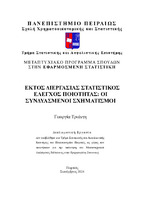Εκτός διεργασίας στατιστικός έλεγχος ποιότητας : οι συνδυασμένοι σχηματισμοί
Off-line statistical quality control : combined arrays

View/
Abstract
In this paper, our aim is to examine the effectiveness of combined arrays as an advanced method for conducting experiments. In statistics, factorial designs play a significant role, as they enable us to simultaneously assess the effects of multiple factors and their interactions, thereby allowing us to reduce the number of experimental trials using fractional factorial designs. These designs are typically orthogonal, ensuring that the effects we seek to estimate remain independent of one another.
Taguchi is recognized for promoting the use of orthogonal arrays, which successfully reduced variability in experiments, thereby improving quality. He is known for employing two types of designs in his analysis: an inner array and an outer array. In an effort to reduce the number of designs to save resources and time, a crossed array design began to be used. By employing response surface methodology and regression analysis, the effects can be estimated. However, the number of runs required remains high, making the process costly, particularly for industries.
The need to reduce costs led to the requirement to decrease the number of experimental runs without compromising the reliability of the results. Many have suggested the use of combined arrays, which require fewer runs than crossed arrays as they are essentially a subset of the latter. These are primarily non-isomorphic orthogonal designs, allowing the selection of an appropriate design depending on the effects that need to be estimated. The optimal designs are chosen based on the D-Efficiency criterion from thousands of available options, depending on the number of factors and experimental trials. This approach achieves time efficiency and reduces the cost of conducting experiments, enabling the experimenter to make reliable decisions.


